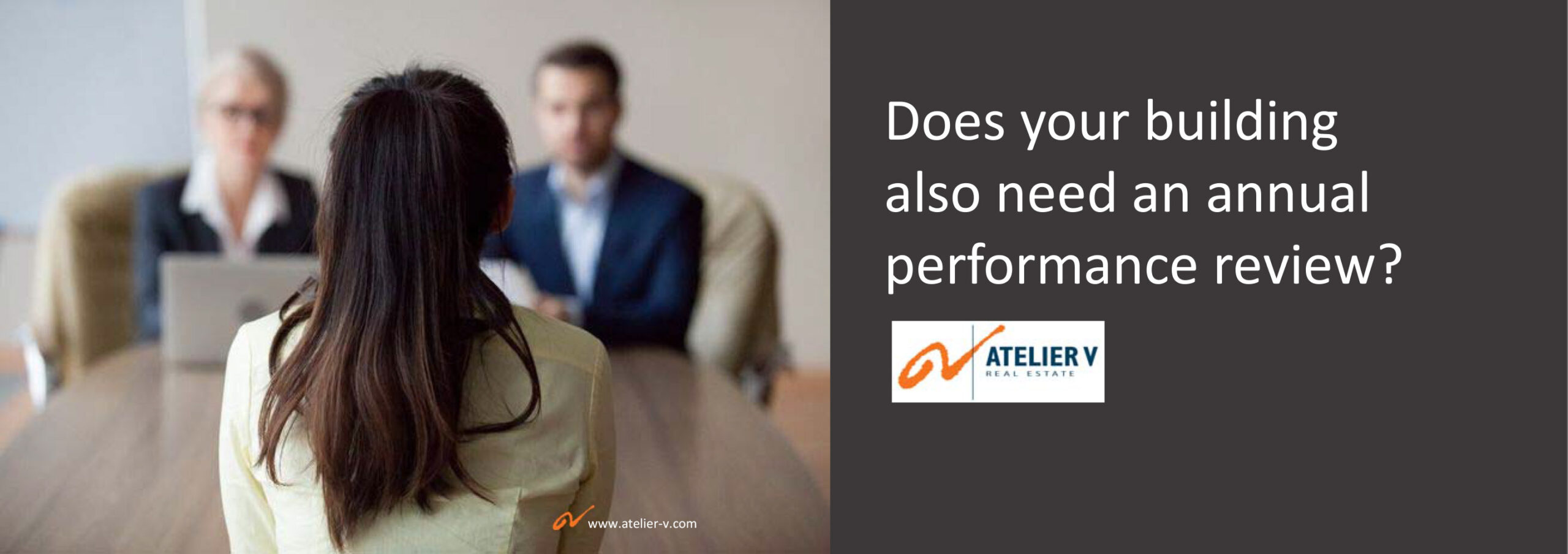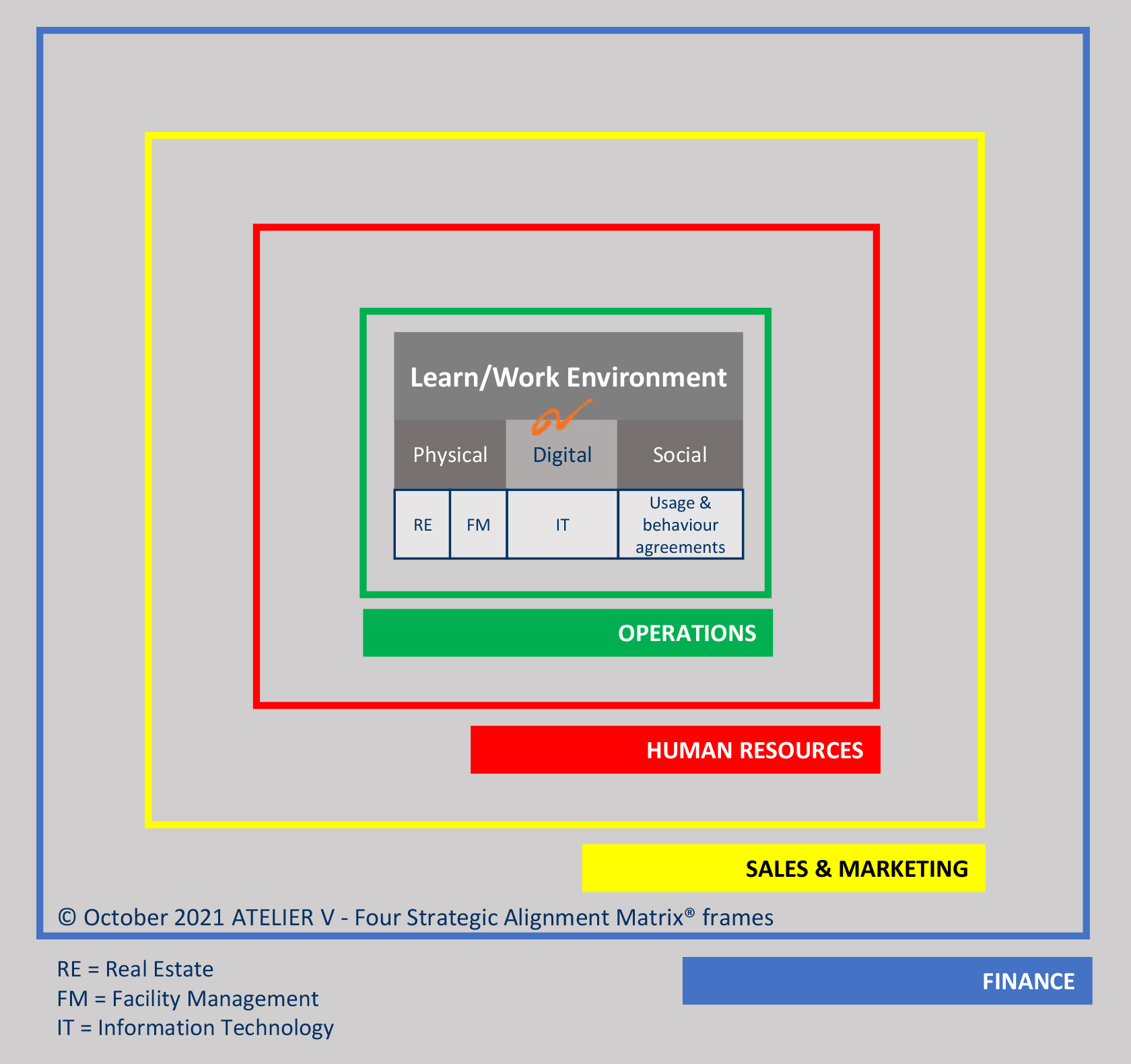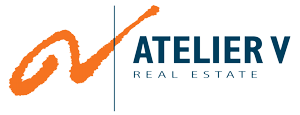
Employee performance review
Performance conversations, also known as performance reviews or appraisals, are a common practice in many organisations. They typically involve a formal discussion between an employee and their manager to assess the employee’s performance, provide feedback, set goals, and discuss career development.
In recent years, there has been a growing recognition that annual performance reviews may not be the most effective approach to managing and developing employee performance. Many organisations are shifting towards more frequent feedback and coaching conversations, which enable timely course corrections and ongoing development. This approach allows for a more dynamic and collaborative approach to performance management.
The learn/work environment has a large effect on how people perform and behave.
Employee satisfaction with the learning/work environment.
The interplay of Real Estate (RE), Facility Management (FM), Information Technology (IT) and Human Resourses (HR) plays a crucial role in creating an effective learning/work environment that is conducive. It makes sense that the Human Resources department takes the lead in orchestrating the experience of people in places that matter and work—aligning the place to the people it has to support because place comes after people. Work on-site and distantly in third places or at home are equal. The where, when, how, what and why of work – is no longer defined by a fixed time and a place to work. Realising simultaneously that work is what you do and not a place.
To what extent do the physical (Bricks) and digital (Bytes) work environment support their work, well-being and health?
There is a difference between employee needs and preferences. Needs have the properties of hygiene factors. When needs are not met it causes dissatisfaction. Preferences are motivators when met they increase satisfaction. To increase satisfaction with the learn/work environment, both employee needs and preferences must be met.
However, it is also closely related to satisfaction with the social (Behaviour) learning/work environment and the work itself (work culture, job demand, management style and level of autonomy).
Besides the learning/work activities or tasks, the workers’ job characteristics and students’ learning styles influence the perceived fit of the learning/work environment, as do behavioural patterns, psychological needs, and demographic characteristics.
The figure shows how the four Strategic Alignment Matrix frames constrain the Physical (bricks), Digital (bytes), and Social (behaviour) components of a learning/work environment.

The periodic Human Resources (HR) review pays attention to employees’ performance but little or no attention to their environment. A questionnaire (a light version of a post-occupancy evaluation) about the learning/work environment, in combination with the periodic HR performance review, offers opportunities to attract, better facilitate, and retain employees.
By adding Financial, HR, Real Estate, Facility Management and IT data and triangulating them with the occupancy evaluation, the fit for purpose can be assessed more holistically. They leverage each other when information is exchanged in decision-making. By including discussions on the learning/work environment in performance conversations, organisations can gain insights into areas where improvements can be made. These conversations provide an opportunity for employees to express their needs, concerns, and suggestions for creating a more positive and productive learning/work environment.
The manager assesses the employee’s performance based on predetermined criteria, such as goals, key performance indicators (KPIs), or competencies. They provide feedback on strengths and areas for improvement. In addition to evaluating individual performance, assessing and discussing the learning/work environment in which employees operate is also beneficial. This broader assessment can provide valuable insights into the factors affecting an employee’s productivity, engagement, well-being and overall job satisfaction.
Stress test scan learn/work environment
Environments are either adding energy or draining energy, increasing your focus or decreasing your focus. A management team aware of the strategic opportunities of a harmonised environment (Physical, Digital and Social space), together with the help of interdisciplinary specialists, can make a difference in unlocking and unleashing human potential.
An A3 Strategic Management Canvas or Accommodation Roadmap helps define and navigate your own path and pace in the ever-changing, complex physical, digital and social ecosystem. Regular performance reviews (Post-Occupancy Evaluation – POE) of the learning/work environment are a tool for managing the knowledge required to ensure continuous improvement (learning organisation). In particular, they reveal how well a building supports the occupying organisation and aligns with the sustainability ambitions.
Periodically conducting an environment appraisal (user, area, building and money), with a 360° feedback assessment on matters that contribute to policy goals with their prioritization, is an essential input to assess the degree of being in control with the learn/work environment and to fine-tune. Not only is measurement information required, but you also need values to determine an adequate learning/work environment for your specific national and local context.
Periodic measuring of user satisfaction helps to identify a mismatch between the learning/work environment and the current educational process in a timely manner. It also prioritises interventions based on the users’ perceived fit of their needs and abilities with the learning/work environment. This provides more customisation and more attention to differences between organisational units. Measuring hard and soft data provides feedback and a sharper focus in addition to gut feelings, experiences, or observations.
‘Does your built environment still meet your present needs and wishes?’
In addition to measuring the hard objective data (area, building, money), the soft subjective data on user satisfaction and behaviour is also relevant. This enables answering the following four sub-questions to address the main question: ‘Is the learning/work environment desirable and adding relevant value?’
Measuring hard and soft data provides feedback and a sharper focus in addition to gut feelings, experiences or observations. The performance appraisal should focus on more dynamic, holistic, yet equally simple solutions that consist of two parts: determining the objective quality of the learning/work environment using, for example, the Real Estate Norm method and measuring the subjective user experience through an online questionnaire and in-depth interviews. Be aware that you only ask for information you want to act on. Measuring both quantitative and qualitative makes the measurements more meaningful.
Workspace Alignment
One should consider several factors when evaluating employee performance and satisfaction with the learning/work environment.
- Physical Workspace: Real Estate (RE), including building layout, amenities, design and other physical infrastructure, can significantly impact employee productivity, engagement and overall satisfaction. Factors such as ergonomic furniture, adequate lighting, proper ventilation, temperature, noise control and access to green spaces are essential for creating a comfortable and healthy work environment.
Facility Management (FM) encompasses various aspects of maintaining and managing the physical workplace. This includes ensuring cleanliness, safety, security, and the availability of essential facilities such as meeting rooms, restrooms, and break areas. Effective FM practices contribute to employees’ well-being and satisfaction with the learning/work environment. - Digital Workspace: Information Technology (IT) plays a critical role in supporting employees’ digital work environment. Reliable and efficient digital infrastructure, including network connectivity, hardware, software, and collaboration tools, enables employees to perform their tasks effectively, collaborate with colleagues, and remotely access necessary resources. This allows employees to enjoy the freedom of being able to work from anywhere and the flexibility to adapt their work to their lives rather than the other way around.
- Social Workspace: Human Resources (HR) plays a vital role in ensuring that the work environment aligns with employees’ needs and expectations. This includes implementing policies and programs that promote work-life balance, reduce work-related stress, provide professional development opportunities, and foster a positive and inclusive culture. HR can also gather employee feedback to identify areas for improvement and address any concerns related to the learning/work environment.
In summary, the physical, digital, and social learning/work environments are all important in supporting employees’ work, well-being, and health. To align the physical and digital work environments with employee needs, organisations should prioritise a people-centred approach. This involves considering employee preferences and feedback and providing flexibility in how and where work is performed.
The integration of Real Estate (RE), Facility Management (FM), Information Technology (IT), and Human Resources (HR) becomes crucial in creating a cohesive and supportive environment that enhances work, well-being, and health. Regular assessments and employee feedback can help organisations identify areas for improvement and create a positive and supportive learning/work environment.
Data driven approach measures what matter
The role of the real estate, facility, and IT manager is supportive in many organisations. A role in which often existing assumptions are fulfilled and not in which these assumptions are established. In an accommodation project, however, this supporting role is not sufficient.
The real estate, facility, or IT manager must profile himself and be able to discuss organisational goals from the operational to the strategic level, translate these into learning/work environment consequences, and return them to relevant management information.
He must know the factors determining whether the learning/work environment will work for the organisation. Data-driven decision-making is required to bridge the gap and achieve alignment at a strategic level instead of lagging behind the facts.
Begin by clarifying the goals and objectives of the building performance review. What aspects do you want to assess? Are there any specific targets or benchmarks you want to achieve?
- How do you transparently and proactively align the capacity and specifications of the learning/work environment with the organisational strategy to communicate with the stakeholders?
- How do you integrate Real Estate, Facility Management and Information Technology assets into a coherent learning/work environment (cross-functional integration – the whole is more than the sum of its parts)?
- How do you keep the accommodation aligned with the dynamic strategy after delivery so that it remains adequate (periodic 360° feedback evaluation)?
- How do you involve the management team and the users in coordinating and future-proofing the whole (brief /design and evaluations)?
- What does a (periodic) evaluation of the learning/work environment consist of to improve and secure performance?
- How do you align accommodation risk management with the organisation’s approach to risk management?
- How do you enrich the input for quarterly reports, the annual budget and the annual report with qualitative data in addition to the quantitative data?
The answers to the above seven questions give insight into where it aligns with policy and strategy and where there are substantial deviations. How bad are the deviations, and what can go wrong as a result (risks)? Is adjustment necessary/desired? What does it yield, and what does it cost in terms of effort/money?
The Real Estate GPS offers smart, systematic data collection that considers that the specific requirements and focus areas may vary depending on the type of building and its intended use. The Key Performance Indicators (KPIs) relevant to your building’s operations and objectives are based on the eight constraints of a project: Scope, Time, Resources, Experience, Risk, Information, Cost, and Quality (STRERICQ). This supports a periodic 360° feedback survey about the learn/work environment to unlock potential and formulate the risks, the control measures and the actions. An approach that integrates many different angles into a more cohesive whole.
In general, key Performance Indicators (KPIs) or performance indicators must be convertible into actions. For each KPI, ask, ‘What do we do with it in practice?’. If you don’t have a concrete answer to this, it’s not a useful KPI. In practice, many KPIs are often not used but only processed in a dashboard. One should focus on services and policy objectives, not on producing figures. And always link the KPIs to the relevant department or team that can influence them.
The two elementary analyses (objective audits) for quality assurance are:
A third additional analysis is:
- Satisfaction analysis (subjective opinion survey) – Are the accommodation’s users (employees, students) satisfied and motivated by the learning/work environment? (Engagement) How do they perceive the contribution of the environment to their productivity, study yield, safety, health and well-being?
Success is virtually assured when goals are formulated as concretely and objectively as possible, prioritised based on their impact and feasibility, and improvement plans are drawn up so there is no doubt about how the plan should be implemented. Indicating in advance how the performance of the learning/work environment is evaluated contributes to creating a feedback loop.
Making data SMARTI (Specific, Measurable, Acceptable, Realistic, Time-bound and Inspiring) in a language for non-professionals in real estate, facility management, and information technology makes communication easier. Consequences for the learning/work environment due to changing ambition levels due to different insights about education and/or external developments can thus be mapped out, discussed and integrally weighed earlier. It’s about using measures as feedback for ongoing business improvement.
“Don’t measure to prove; measure to improve.”
A Six Pack dashboard (360-degree performance review) and Customer Journey with CREM/FM Touchpoints ensure that all relevant data is objectively, measurably recorded, and monitored.
Comparing multiple datasets reveals relationships that were previously hidden. This means that decision-making no longer has to be based on gut feeling and suspicions alone. Conversations can take place that might not have taken place without these facts and data. It can then also serve for the governance of the real estate portfolio, consultation with internal users and external suppliers, input for an accommodation section in the financial statements, substantiation of the annual budget, and as a Human Capital instrument.
This transparent way of working prevents an ad hoc approach, in which goals and criteria constantly shift, and it is not possible to determine afterwards whether the intended results have been achieved. It also makes periodic reassessment possible so that the focus remains on the set (current) goals instead of just reporting on the past. It also helps in exploring the degree of future resilience.
Communicate findings and action plans: Share the review findings with relevant stakeholders, including successes and improvement areas. Collaboratively develop action plans to address deficiencies and involve key individuals or departments responsible for implementing the necessary changes.
Remember that an annual building performance review should be an ongoing process. Regular monitoring, evaluation, and continuous improvement efforts are crucial for optimising building performance and achieving long-term (sustainability) goals.
Advantages of a more data-driven decision making:
- Gaining more insight and control.
- A more efficient decision-making process.
- A better understanding of problems and issues.
- Better solutions/decisions through an iterative process.
